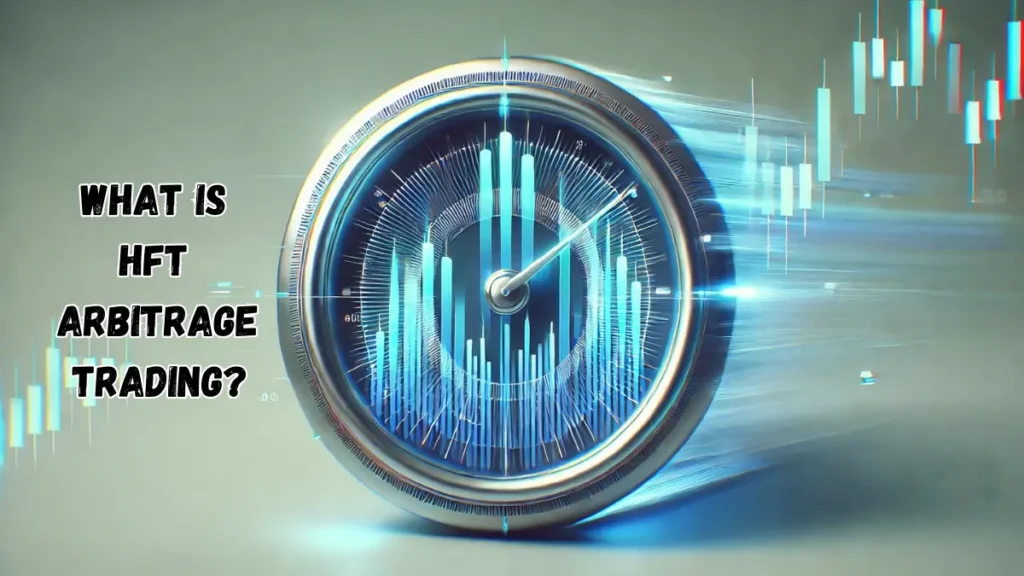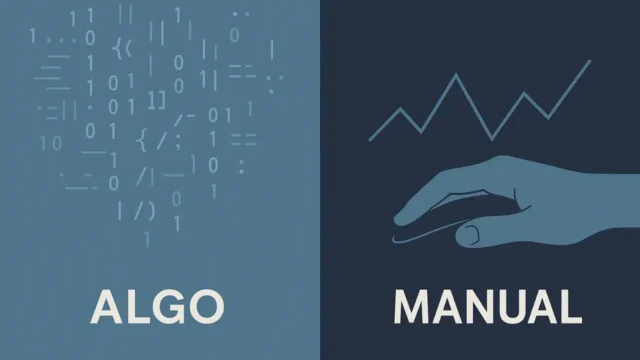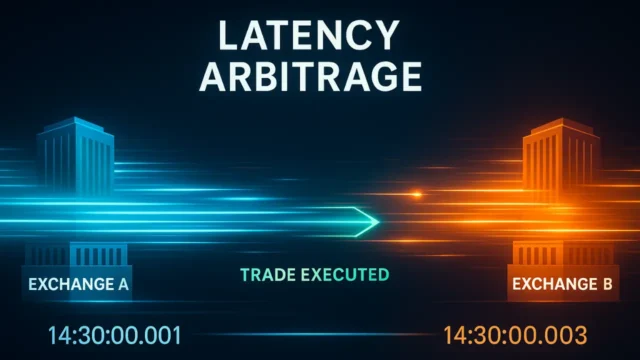Follow Us
What is HFT Arbitrage Trading?

Table of Contents
HFT arbitrage is the financial world’s version of legal theft, but only if you know what you’re doing.
It is the art of exploiting tiny price inefficiencies at lightning speed, raking in small but consistent profits before the market catches up.
But it is for only who understands the mechanics, it’s one of the sharpest edges in trading.
What is Arbitrage in HFT?
At its core, arbitrage means buying low and selling high at the same time, on different exchanges, markets, or asset classes to pocket the price difference before it disappears.
Now, in the world of high frequency trading (HFT), we are doing this at speeds faster than human reaction time, using automated algorithms & low-latency infrastructure to front-run inefficiencies.
Well if this overwhelmed you here is an example:
Classic Exchange Arbitrage
Imagine BTC is trading at $50,000 on Exchange A and $50,050 on Exchange B. An HFT arbitrage bot will buy at $50,000 and sell at $50,050 in milliseconds, locking in a risk-free profit of $50 per BTC, before regular traders even realize the gap existed.
Multiply this by thousands of trades per day, and you start to see why HFT firms are printing money.
Types of HFT Arbitrage
1. Latency Arbitrage
Speed is money. If your trading system can react even a fraction of a millisecond faster than others, you can spot price movements before they update across different exchanges.
This is why HFT firms spend millions on microwave towers, colocation servers, and fiber-optic cables, because the faster you execute, the more money you make.
Speed helps in scenarios like:
- News breaks that a stock is pumping.
- Your algo gets the info and executes before slower market participants react.
- You buy before the price spikes & offload at a higher price.
This is not about being smart, it is about being first.
2. Market Making Arbitrage
Market makers help keep the market fluid by always quoting buy and sell prices.
But if there’s a price gap between markets, high-frequency trading arbitrageurs can jump in and make the most of that situation.
They hit the bid on one exchange and lift the ask on another, pocketing the spread without carrying directional risk.
Why This Works:
- If Exchange A’s bid is $100.10 and Exchange B’s ask is $100.00, an arbitrage bot can buy at $100.00 and sell at $100.10 instantly.
- That’s a zero-risk $0.10 profit per share, executed many times per day.
3. Statistical Arbitrage (Stat Arb)
Statistical arbitrage uses quantitative models to identify pairs of assets that historically move together.
When they deviate from their expected correlation, HFT algos step in to trade the divergence.
Example:
- Let’s say Apple (AAPL) and Microsoft (MSFT) normally have a strong correlation.
- If AAPL drops 1% while MSFT stays flat, an HFT stat arb bot might short MSFT and buy AAPL, assuming the spread will close.
- When prices converge, the bot exits the trade for a profit.
This might not be a sure thing, but if you have a strong model and act quickly, you might have an advantage.
Why Retail Traders Can’t Compete with HFT Firms
Thinking of trying HFT arbitrage from your bedroom? Bad idea. Here’s why retail traders don’t stand a chance:
1. Infrastructure Costs Are Insane
- HFT firms pay millions for ultra-fast servers and private data feeds.
- They colocate their machines inside exchange data centers to cut execution time down to microseconds.
- You? You’re sitting at home with a WiFi connection and a broker that front-runs you. Game over.
2. You’re Competing With AI, Not People
- HFT strategies run on machine learning models optimized for every possible market scenario.
- If you think you can “spot” an arbitrage manually, it’s already gone.
3. Market Access is Limited
- Big players use direct market access (DMA), cutting out middlemen for near-instant fills.
- Your orders go through a brokerage with delays and slippage, good luck executing at HFT speeds.
Related Post:
What is Mid Frequency Trading (MFT)? A Practical Guide
Is There Any Way for Small Traders to Leverage Arbitrage?
Yes, but not in the pure HFT sense. Retail traders can explore arbitrage-like opportunities in slower-moving markets like crypto or forex, where inefficiencies last longer.
1. Crypto Arbitrage
- Crypto exchanges are not as optimized as stock markets, so arbitrage gaps can exist for minutes instead of milliseconds.
- Cross-exchange price differences happen due to liquidity mismatches, but manual trading is still risky due to transfer delays.
2. Event-Driven Arbitrage
- If a stock is set to be acquired at $50/share but trades at $48, that’s an arbitrage play, if the deal goes through.
- Retail traders can exploit these inefficiencies without needing HFT speeds.
3. DeFi Yield Arbitrage
- In DeFi, lending protocols offer variable interest rates, creating arbitrage between platforms.
- Borrow at a low rate on Platform A, lend at a higher rate on Platform B, and pocket the difference.
Final Word: HFT Arbitrage is a Shark Tank
HFT arbitrage trading is a brutal, zero-sum game where speed, capital, and infrastructure determine who wins.
If you are not plugged into an ultra-low-latency trading system, you are not in the game.
Can retail traders profit from arbitrage? Sometimes, but it’s not true HFT.
Instead, focus on slower, less competitive arbitrage opportunities where inefficiencies last longer than a blink of an eye.
Disclaimer:
This content is for informational purposes only and should not be considered financial advice.
Read full Disclaimer.




